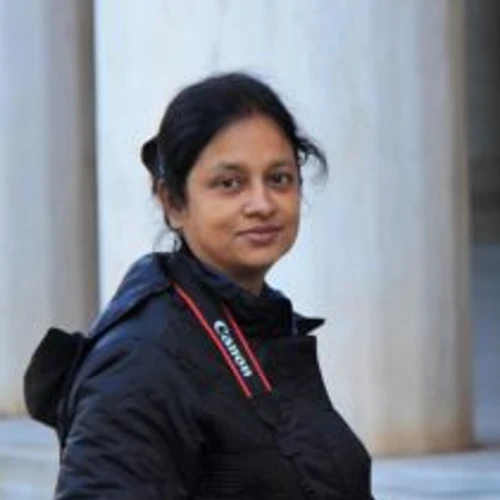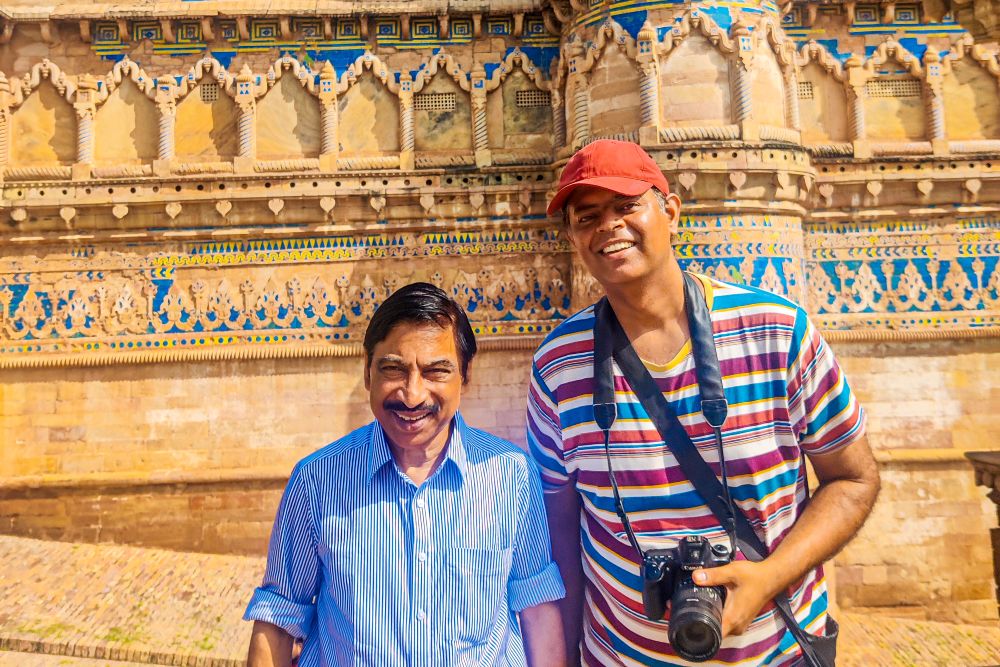Stones murmur tales of distant past
One has to have the time enough to decipher and keep!
Time has weathered them, earthquakes have displaced them
Listen, these stones speak truths, profound and deep!
In the Gwalior MP Heritage Trail, we had the privilege of being guided by KK Muhammed Padma Shri, a renowned Indian archaeologist who has dedicated his lifetime to deciphering the tales hidden within the stones. Our heritage journey commenced in Bateshwar, taking us through the northern regions of Madhya Pradesh in partnership with Times Passion Trails, spanning Morena, Shivpuri, and Datia.
MORENA
The Bateshwar temple complex, once devastated by an 18th-century earthquake and overgrown with dense foliage, had, for many years, served as a refuge for dacoits from the notorious Chambal Valley, a legacy that persisted until the early 2000s. During our visit, Muhammed sir shared captivating anecdotes about his interactions with the dacoits who once ruled this region. He recounted how he successfully persuaded them to relinquish control of the temple area, allowing for its much-needed restoration and rejuvenation.
With a wealth of knowledge and a visual aid of pictures, he offered an in-depth explanation, showcasing the temples’ conditions both before and after the painstaking restoration efforts.
It has the highest concentration of temples in India (Aihole in Karnataka has 120 temples). The clock ticked away as we walked around the complex, trying to decipher the stories from the stones that waited to be placed back to the frame they originally belonged to. Bateshwar temple is also the oldest among all the temples we saw during this trail.
Padhavali and Mitaoli temple dated back to 10th century while Kakkanmath temple dated to 11th century. Each temple is unique in its own way. Padaoli has 3D sculptures, the statues almost emerging out of the panels. Mitaoli Temple is famous as Chausatth Yoigini Temple.
From Mitaoli we traveled 22.7 km towards the Kakkanmath Temple. Alighting from the bus a most stupefying sight greets us – that of a temple that defies gravity!
Today, what unfolds before our eyes is the inner sanctum of the temple, while the remaining structure lies in ruins, strewn haphazardly throughout the temple grounds. Our neck muscles would probably be in worse shape in comparison to the strong jig-saw bond of the stones that stand precariously piled up one above the other.
Fortuitously, our timing for this visit couldn’t have been better. The dwindling sunlight of the setting sun casts a captivating radiance upon the temple’s façade, rendering it a captivating subject for photography.
Ambitious plans are underway to carefully disassemble the existing structure, stone by stone, with each block meticulously numbered. The aim is to embark on a comprehensive reconstruction of the entire temple. Yet, despite these imminent changes, I find myself enamored by the hauntingly beautiful appearance of the temple in its current state.
SHIVPURI
Shivpuri 116 km south of Gwalior was another exciting excursion. It is famous for graceful, intricately embellished marble chhatris erected for Scindia rulers. The Scindia royal family had employed descendants of the artisans who had built the Taj Mahal to build the Chhatris.
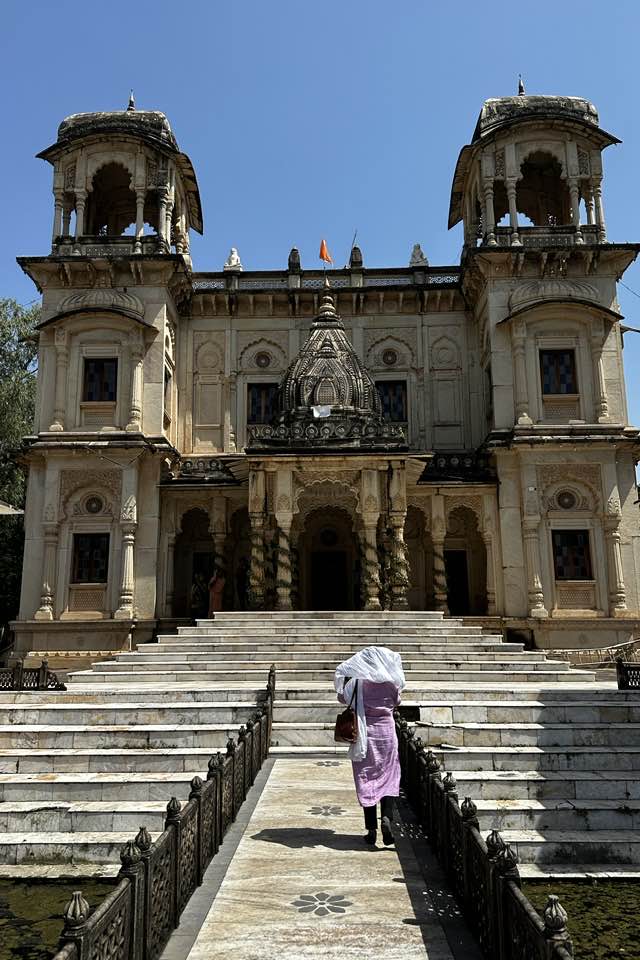
The mesmerizing beauty of the colorful stone inlay work and delicate jaali work within these structures is nothing short of extraordinary. Their intricate designs and craftsmanship are truly stunning.
Among the most remarkable features are the intricately carved perforated stone screens that adorn the tombs. These are not only aesthetically pleasing but also exceptionally rare and precious, representing an art form of great significance and skill.
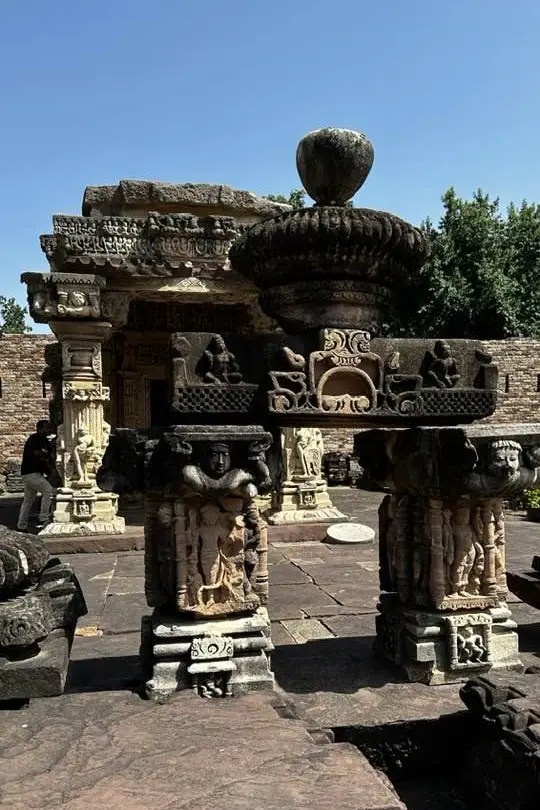
Robust blocks of stone piled up on one another formed the fort wall of Surwaya Gadi. As we wandered through the fort’s interior, it was impossible not to be captivated by the meticulously sculpted stone carvings that adorned its walls. These carvings, with their exquisite detailing, vividly depicted the stories of Hindu Gods and Goddesses, creating a profound connection to the rich religious and cultural history of the region.
What makes these structures even more remarkable is the medium itself: STONES. Throughout history, stones have served as powerful symbols, whether as a mark of respect for the departed, a means of fortification and protection, or as a medium for prayer and communication. Their enduring presence and timeless role in conveying messages and stories make them an integral part of the cultural heritage and artistic legacy of this region.
MADHAV NATIONAL PARK
At Shivpuri we were treated to some soothing greens. We headed to Madhav National Park. Our hopeful eyes scan every inch of the forest land to spot a stray tiger or leopard. Spot we did, not tigers or leopards but several spotted deer, barking deer!
The long winding path led us to George Castle at the highest point of Madhav National Park. The quirky story that is associated with this castle is that Jiwaji Rao Scindhia built this castle for the overnight halt of King George when he invited him over for hunting tigers. But while on his way George had spotted the tiger and killed it, he therefore never stayed in the Castle specially built for him.
Every day, hordes of tourists and travelers visit the castle to see what the King missed!
DATIA
We ventured into Datia to immerse ourselves in the tranquil temple surroundings of Sonagiri. From a distance the picturesque view of the green hillside adorned with 103 white temples looked mesmerizing and inviting.
One striking feature that immediately catches the eye is the diversity in the design of each temple’s pinnacle. Some resemble the domes of mosques, others the steeples of churches, and still others adhere to traditional Hindu temple architectural styles. This rich variety of designs beautifully exemplifies religious harmony in the area.
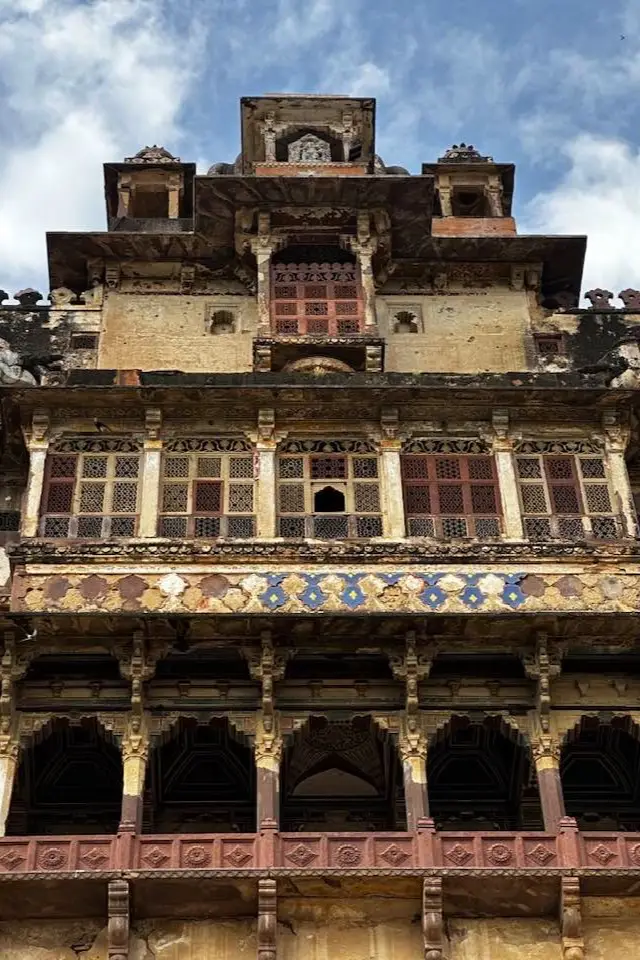
Our next destination was the Veer Singh Palace, a mere 1.5 km away from the quaint village of Sonagiri. As we approached the colossal structure, its seven floors and an astounding 440 rooms left us utterly awestruck. Interestingly, this grand palace was originally constructed by King Veer Singh of Datia to accommodate King Jehangir for just a single night.
The architectural marvel of the palace is quite evident, especially in the robust angles that support each of its seven floors. As we explored its interior, we were treated to the sight of some rooms adorned with intricate artwork in vibrant vegetable colors that have miraculously retained their brilliance over time.
The palace’s infrastructure is equally impressive, with sturdy pillars and graceful arches gracing its corridors, making them perfect subjects for photography enthusiasts. However, the rooms themselves, while architecturally fascinating, convey a sense of starkness and emptiness.
The journey from one floor to another is an adventure in itself, with narrow, steep steps and concealed entrances. We learned that these peculiar features were intentionally designed to confound potential invaders, providing a strategic advantage in case the palace were ever breached by enemies. The palace, with its rich history and unique design, left us with a profound appreciation for the ingenious craftsmanship and foresight of its builders.
Pitambara Matt, a revered temple of Datia. It is believed the resident Goddess of this temple Dhoomavati Devi’s blessings are a must for success in any kind of quest. Another special feature of this temple is that devotees offer savouries to the Goddess. The shrines here house Goddess Bagalamukhi, Parashuram, Shiv ling, Hanuman and Dhoomavati Devi. Photography is strictly prohibited inside this temple.
GWALIOR
Two complete days of our five days of Times Passion Trail were dedicated for this beautiful district – Gwalior, one of the 52 districts of Madhya Pradesh. The city is a magnificent blend of museums and mahals, temples and tombs!
PALACES AND MUSEUMS IN GWALIOR
Standing on a steep mass of sandstone, Gwalior Fort dominates the city and is its most significant monument. It has been the scene of momentous events, imprisonment, battles and jauhars. The palace is a labyrinth and we got a good guide who explained the places of importance within the fort very well.
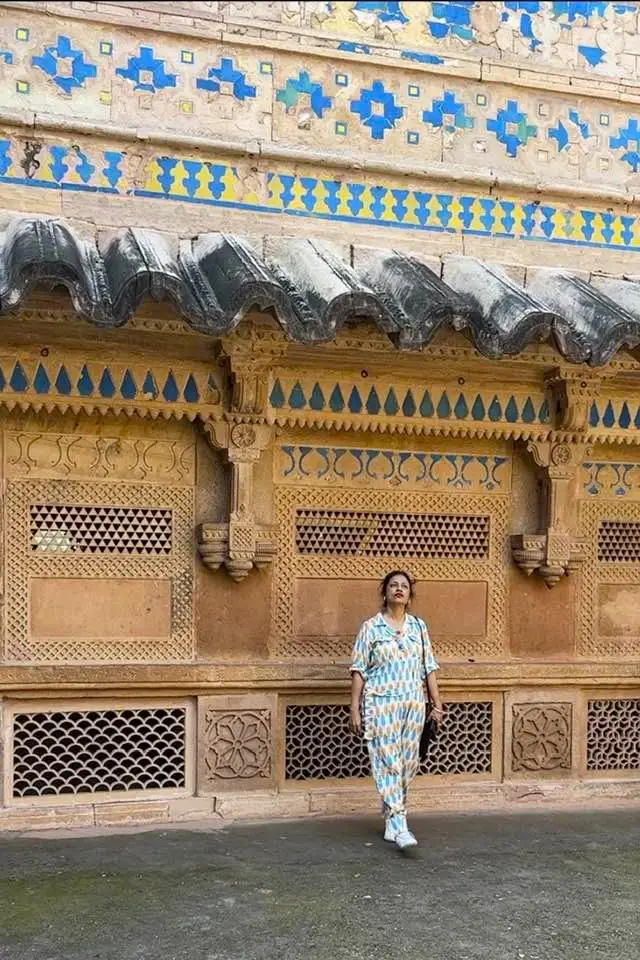
One particular room of Gwalior Fort that stands out distinctly in my mind is the Jhoola Kaksh (room with swings). It had hooks that held swings for the eight queens of Raja Man Singh. Years later when Aurangzeb took over the fort, he had hung his brother Murad Bakhsh, the same brother who helped him defeat Dara Shikoh, their elder brother, in that very Jhoola Kaksh.
Gujri Mahal, Gwalior, India – Locked behind a series of 7 doors in this Gujri Mahal archaeological museum we met Shalabhanjika – a woman so beautiful that she can make a tree blossom with the merest touch of her foot. This priceless sculpture from the 10-11th Century AD is famous for her fine delicate features and the mysterious smile playing on her lips. In 1985 this sculpture was presented in an exhibition in France. At that time, its cost was estimated at 60 Lakh rupees!!!
Besides that, the museum is a treasure of many heritage artifacts, sculptures and musical instruments each of immense historic value.
Same goes for Jai Vilas Palace and Museum, but on a much grander scale with eclectic collections of antique art, weaponry, grand dining table, artefacts, and old pictures. Even three hours of stroll through the displays at a moderate pace seemed less. Someday I have to return to absorb the complete essence of this grand palace.
Mr Srinivasa Verma, Additional Director General of Police Gwalior during the inaugural speech on DAY 1 did say that after this trip we would want to come back for more, the city has so much to offer in terms of heritage.
TEMPLES IN GWALIOR
At Sahastrabahu Temple we were captivated by the enchanting narrative of King Mahipala’s delicate balancing act. He erected two temples side by side, one dedicated to his mother’s devotion to Shivji and the other to his wife’s reverence for Vishnuji, weaving a beautiful story of devotion and harmony.
Teli ka Mandir, a temple financed by an Oil Merchant for King Mihir Bhoj, is the oldest surviving structure within Gwalior Fort complex. This 100ft. tall temple was devoid of mandap or pillared hall, instead it just had a porch and a doorway dominated with figures of flying Garuda. The temple is dedicated to Lord Vishnu.
SILENT SEPULCHERS OF GWALIOR
Both Tansen Tomb and Muhammad Ghaus Tomb lie within the same complex. While the place is of supreme reverence for Tansen music lovers, tourists come here in huge numbers to appreciate the architectural details of the tomb structures. The monument built here has a mix of architecture, specifically from Gujarat and Rajasthan, which eventually evolved into Indo-Muslim architecture.
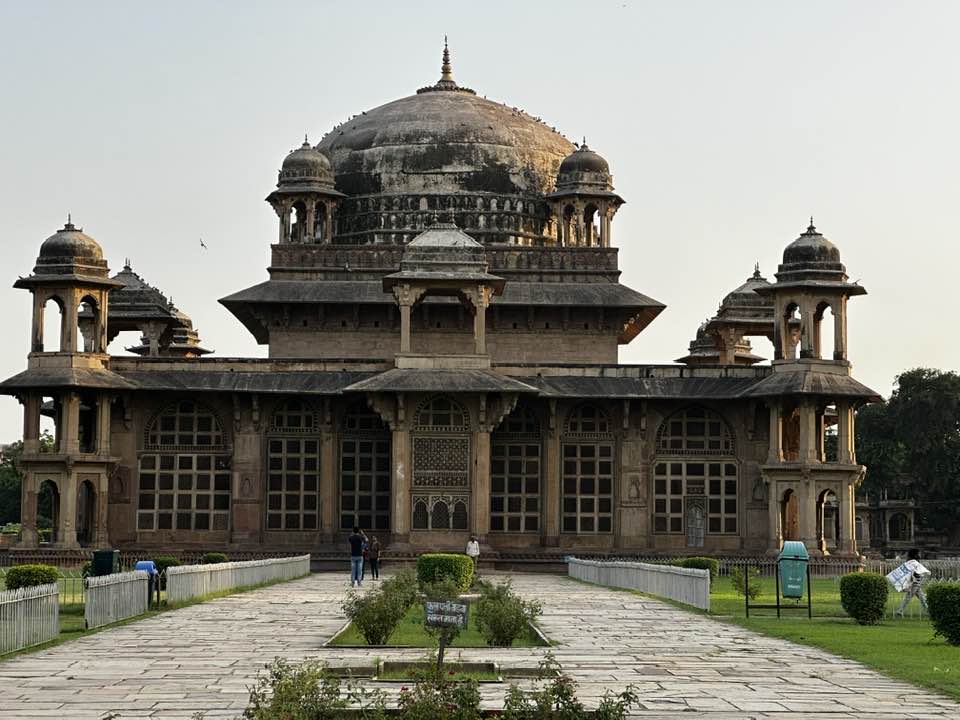
Originally the structure was covered in blue glazed tiles. Sadly, nothing of those brilliant ceramic tiles remains anymore. Tansen’s tomb, a fairly simple structure with an open pavilion.
Khoob ladi Mardani woh toh Jhansi wali Rani thi…
This Gwalior MP Heritage trail was an eye-opener to the fact that the brave Jhansi ki Rani spent her last moments in Gwalior. Her last fight with Britishers lasted here in Gwalior Fort for 2 weeks, during which she displayed unwavering courage until her final breath. Even today, the eternal flame of Amar Jyoti continues to burn brightly in her honor. A detailed wall panel here in this Jhansi memorial park depicts her life story.
JAIN STATUES IN GWALIOR
At Siddhachal we were face to face with monumental statues of Jain legends created flawlessly on the rocks. Sad to see many of them mutilated by the Islamic Invaders, though some of them have been given a face lift later. Siddhachal caves have almost thirty-one Jain temples that include many caves, small reliefs on the walls, on both sides of the slope of the Urwahi road in the fort, along the Urwahi valley.
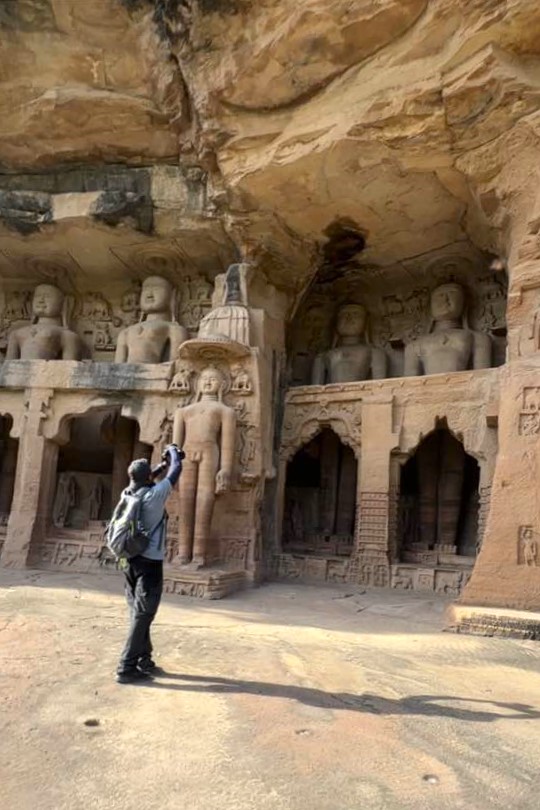
The Gopachal rock-cut monuments, also known as the Gopachal Parvat Jaina, constitute a fascinating part of the extensive collection of nearly 100 Jain monuments scattered in and around Gwalior city. Remarkably, these monuments predate the Siddhachal Caves we explored on DAY 3, dating back to a period spanning from the 7th to the 15th centuries.
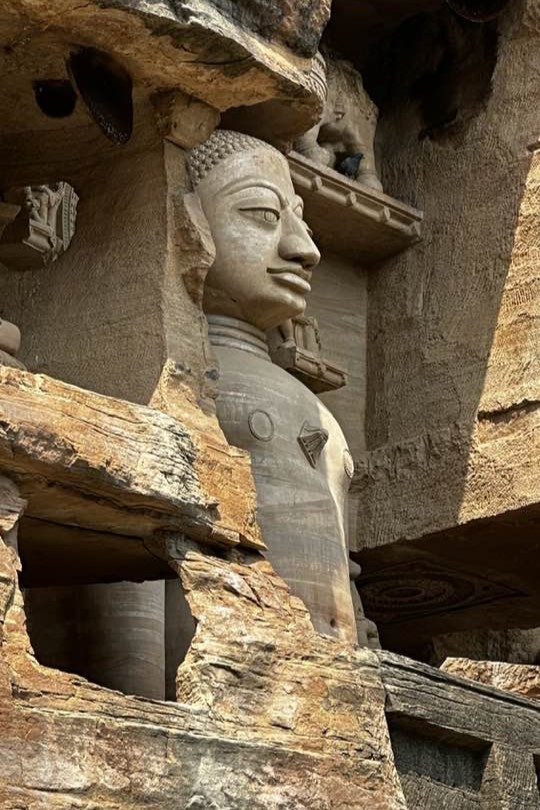
The ascent to these caves is notably steeper and longer compared to our visits to the Mitaoli Temple and the mountain-top Jain temples at Sonagiri. However, once we reached the summit, we found ourselves utterly engrossed in the captivating array of Jain muni statues. Many of these statues bore signs of defacement, while some had received careful touch-ups. Fortunately, we were able to marvel at the Parsvanatha Jain Muni statue, adorned with five serpent hoods, which appeared remarkably well-preserved.
We were in for a surprise at the Baija Taal Cultural Complex, Gwalior’s newest attraction. Gwalior Municipal Corporation had organised a musical evening for all of us.
Baija Taal was constructed by Baija Baj, a member of the Scindia family. In its original form, an oval-shaped tank graced the location, featuring bridges that led to stone steps encircling it. This tank had been designed for ceremonial and festive purposes. Today, it has been transformed and reimagined into a cultural complex housing an open-air theatre.
Gathering together at Baija Taal, we had the pleasure of witnessing a captivating dance and music performance by the exceptionally talented students of Raja Man Singh College in Gwalior. Following this remarkable display of artistic prowess, the Gwalior Municipal Corporation extended their appreciation by presenting us with thoughtful mementos. It was undeniably an evening filled with excitement and memorable moments.
In the next leg of our journey, we headed 3.4 km south-west of Baija Taal to Maharaj Bada.
Maharaj Bada, also known as Jayaaji Chowk, holds great significance in Gwalior, Madhya Pradesh, India. Serving as the heart of Gwalior, Maharaj Bada, often referred to simply as Bada, features a vast square like the ones we get to see in European countries. This chowk/square is surrounded by historic elements such as a former opera house, banking institutions, quaint refreshment stands, as well as a notable municipal market building. The place looks magical at night.
FOOD SCENE IN GWALIOR
On all five days of our journey, we stopped at several local eateries for lunch. They are mainly managed by the local government and tourism board. The staff were very courteous and catered well to the 25+ hungry stomachs.
What is travel without munching on some local bites? We explored a bit of the Gwalior Street food scene. As the Ganesh Chaturthi festival was culminating, the streets were overcrowded. So, we did the next best thing to pick up the local kachoris and samosas for a small get-together in one of our rooms in Taj Usha Kiran. One of the days we had a quick pani-puri eating competition too.
Food and friends, they make the journey complete, I am sure you will agree!
TAJ USHA KIRAN
This travel diary on Gwalior MP Heritage Trail would be incomplete if I don’t mention our comfortable stay in Taj Usha Kiran. It was a delightful surprise from the Times Passion Trail that our accommodation was arranged at the Taj Usha Kiran in Gwalior. To add to our delight, we learned that there would be no changes in our place of stay for the next five days, that meant NO pack-unpack.
We got a grand and warm reception at Taj, their traditional way of welcoming with horse-cart ride, bugle blowing, nagada beats, garlanding with tulsi-mala and application of tilak. Soon after we were ushered to our rooms – mine was a cool tent accommodation. We relished each and every breakfast session and dinner episodes in this grand hotel.
CONCLUSION
This heritage trail in and around Gwalior City Madhya Pradesh was crafted meticulously with judicious use of time that enabled us to cover maximum possible destinations.
This heritage trail around Gwalior City in Madhya Pradesh was thoughtfully structured, allowing us to make the most of our time and explore a multitude of captivating destinations, a wide array of historical sites. Each part of the journey was carefully planned, ensuring that we could immerse ourselves in the rich history and cultural treasures of the region and also include a good dose of fun and food.
It was evident that careful consideration had gone into ensuring that we could truly appreciate the heritage and beauty of Gwalior City and its surroundings.

